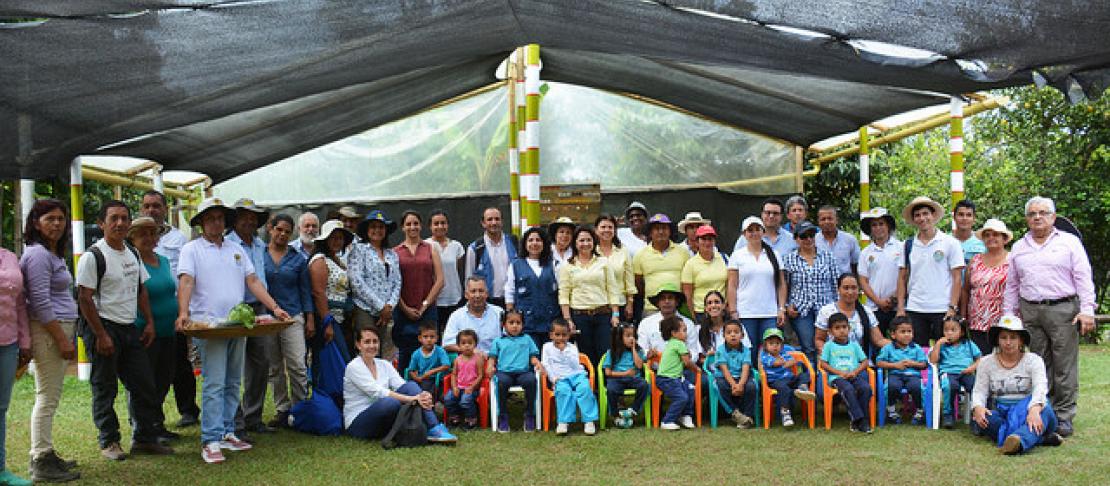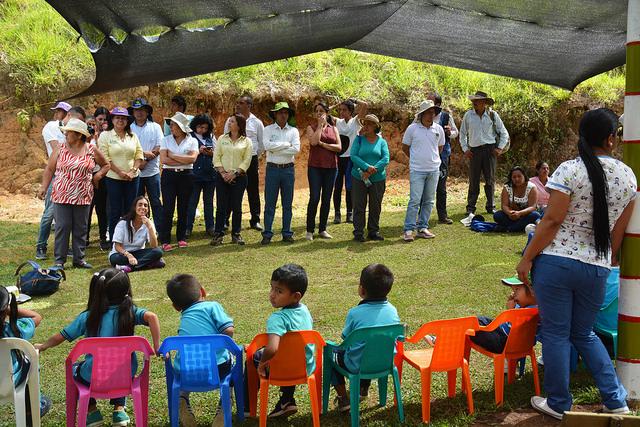Cauca builds momentum for scaling up climate-smart agriculture in Colombia

A wide range of institutional actors gathered in Cauca to immerse themselves into climate-smart agriculture
The level of knowledge in the community is impressive, as well as how the farmers exchange that knowledge, I think Cauca’s Environmental Authority has the capacity to take this experience to other regions and we should take advantage of the funds for climate change adaptation that Colombia has available.”
Mariana Rojas Laserna, Technical Director for Colombia's Ministry of Environment and Sustainability
CCAFS and Ecohabitats Foundation started implementing the climate-smart village (CSV) approach in Cauca about 3 years ago hand-by-hand with a community in the northwest of Popayan. Today different stakeholders along with us have witnessed the impact on climate resilience, livelihoods improvement and community empowerment that the approach is having on a community with huge climatic, socioeconomic and environmental challenges as in many municipalities in Cauca. Cauca represents the geographic, cultural, economic, political and biological diversity of our country in a little more than 3 million hectares (Ortega[1], 2011), attributes that have a great potential to bring at scale Climate-Smart Agriculture (CSA) as a way to go to achieve competitiveness and rural development.
The CSV model, built and strengthened in 16 veredas (villages) of Cauca by the CGIAR Research Program on Climate Change, Agriculture and Food Security (CCAFS) and Ecohabitats Foundation, is going big. Representatives from Colombia’s Ministry of Agriculture and Ministry of Environment, FAO, and Cauca’s departmental authorities were there. They wanted to know first-hand what are the bridges that have been built between the community and the institutions, how much CSA has helped to increase Cauca’s climate resilience and what it means for farmers and their rural development processes, as well as what’s needed to scale the model across the country. This visit was planned with the purpose of informing the updating process of the Integral Climate Change Action Plan for the Agricultural Sector led by MADR and MADS with FAO’s support.
We visited Waldina Bermudez’s lawn, it was buzzing that morning and getting warmer by the minute. In the shadow of the tent installed next to her house, dozens of guests, familiar and unfamiliar faces in Cauca CSV, started taking their seats for breakfast. Everybody seemed to be there: from international organizations to national, regional and local authorities, and farmers from the municipalities of Argelia and Morales who came to exchange the lessons they’ve learned and understood on how to bring the CSV process to their communities.
Liliana Paz and Waldina Bermudez explained the farm adaptation plans approach, the dawn of the CCAFS-Ecohabitats collaboration and the sparking of the community’s interest in adapting to climate change challenges. Cauca’s Environmental Authority (CRC) is no stranger to this—Yesid Duque, its Executive Director, has been involved in the project and understands the importance of linking efforts at local level with the institutional powers that can support the sustainability of these efforts and propel them across levels.
The talk moved from the table to the field, led by Luis Ortega, co-founder of Ecohabitats and a key character in Cauca CSV. Alfredo Chara, the go-to person in Cauca for weather measurements and expertise, ran the visitors through the usage of the low-cost weather stations installed and explained the increasing climate variability that farmers have had to deal with over the last few years. The approach involves a parallel process in which we work with the farmers to understand the relationship between climate and crops using the PICSA methodology, while the Local Technical Agroclimatic Committee (LTAC) of Cauca, led by the Secretariat of Agriculture, discusses hand to hand with IDEAM to determine the climate variability. As a result of the process, the LTAC members develop an Agroclimatic Bulletin with recommendations to mitigate potential risks. At the end, farmers are better informed to plan their crops and to decide whether they should plant or not, what variety to use, or what adaptation options are needed.
In our visit, we went ahead through the coffee bushes to the back of the house to the bicycle water pump, an essential tool for farmers’ water needs in times of drought -- basically making an efficient use of water from underground sources, even for the driest seasons of the year. Farmers were not taking advantage of this water source and now they are not only benefiting from it but rationally using it. The extraction capacity without exhausting the source is 200 liters per day in the rainy season and 100 liters per day in the dry season, 70% of the water extracted is for home needs and 30% for agriculture. Albeiro Rivera and Julio Bermudez, community experts on bicycle water pump, explained how it works, while Yesid Duque, CRC Director, jumps on and pedals for demonstration.
This practice combined with improved beans varieties resistant to drought, pest and diseases and with local climate monitoring allows farmers to produce even when rain decreases ensuring food security and adapting to changing climate conditions. Although CSV farmers were not used to harvest beans nor eating them much, today bean consumption has increased from 0.5kg/year to 3kg/year, saving them at least USD24 per month while improving their nutrition with beans with high level of zinc and iron, according to CIAT and CCAFS research.
This is the way to adapt to climate change, we speak a lot on paper but adaptation must be done in the territory and I am very pleased that the local authorities are so committed to making that change. Our ministry will take care of sharing the lessons from this visit and look for international cooperation allies to help us take CSA to the next level.”
Nelson Lozano, Climate Change Coordinator for Colombia’s Ministry for Agriculture and Rural Development.
After a final look at the newly installed solar panels in Waldina’s farm, which produce enough energy throughout the day to light the entire property, we drove further up to Daniela Campo’s tomato greenhouse. Daniela took charge of the project—with Ecohabitats, community and CCAFS support—to diversify the crops her family grows and to save money to fund her university studies. We gathered in the organic fertilizer factory set up next to the greenhouse to discuss how to achieve clean crops of cherry tomatoes, and their importance for food security for families in Cauca.
All climate smart options implemented by Cauca CSV community are selected based on a climate vulnerability analysis through a participatory process always bearing in mind the local knowledge of its farmers and the scientific knowledge provided by CIAT-CCAFS. For example, CSA options such as the use of organic fertilizer for coffee crop was selected for two main reasons: i) the economic importance of coffee for the farmers which constitutes the main income source, and ii) the potential value added that a low emissions and organic coffee might have in selected markets. Yes, all good so far, but let’s look at the numbers: 33% is the GHG reduction when swapping chemical fertilizers with organic fertilizers in coffee production and 1 ton of harvested coffee generates an average of 430kg of post-harvest waste, which results in a good biomass source for compost production. Today, 70% of CSV farmers had changed the way they handle crop residues, reducing up to 10 times the emissions of CO2-eq (more info here). If this is promoted by CRC for example, and implemented at scale in Cauca, the department’s contribution to Nationally Determined Contributions (NDCs) might be significant and could position it as a low carbon region in Colombia.
The latter is a bright example on how Cauca is implementing Colombian Climate Change Policy in the ground, in articulation with the recently launched Green Growth Policy, which promotes promising practices and technologies that could be scaled to improve agricultural sector performance measured through the green growth indicators. The Green Growth Mission led by the National Planning Department (DNP, in Spanish) carried out the Green Growth Policy formulation and commissioned CCAFS, CIAT and CRECE to develop the Land Productivity component (more info here).
As the day passed, a group of young boys joined us, all suited up in black and white uniforms, with hip haircuts, just out of their high school for the day. They’re very much involved in community work and the CSA initiative seems to have changed their minds about their futures—they all seem to have switched to wanting to pursue a career in environmental engineering and other fields connected to agriculture. This is actually promoted by the Colombian Rural Mission, which states that all activities related to improving livelihoods and quality of life, through which the countryside becomes attractive, need to be promoted widely, considering that most of the younger population prefer to move to the city to study and stay there to work rather than going back to rural areas. Now the vision has changed for CSV youth because they still want to study in the city, but now focused on ways in which they can help their territory.

The final step of the visit was at the Danubio Azul kindergarden. Photo: Alexandra Popescu (CCAFS)
Our final stop was at the Danubio Azul kindergarden, where Adriana Mosquera introduced us to the group of under-5 year old children, who are always happy to have guests. A new garden has been built by the school with the kids, who by now are no strangers to how they should take care of their vegetables and also eat them. “Work in the community with children and young people is key to build a long-term sustainable agriculture,” says Ana Maria Loboguerrero, Regional Program Leader for CCAFS Latin America. “It always warms my heart to see how much things change for the better with every visit we make.”
"It’s impressive how Cauca CSV, through its initiatives, has succeeded in bringing together such a varied range of actors who are so engaged in taking the initiative further,” says Adriana Martin of FAO in Colombia. “This knowledge exchange is vital for strengthening institutional ties and the climate-smart processes. We are by nature partners with CCAFS and we will work together to find new ways to support these initiatives in the long run."
As of today, Cauca is positioned as a leader promoting the linkages between environment and agriculture and has set an example on how to successfully generate a positive impact in the Colombian community through a climate smart vision of their future. Though, the recently signed Peace Agreement brings huge challenges that will need to be addressed, the CSV approach can make a significant contribution because it aims for empowering rural communities and preparing them for a sustainable future.
[1] Ortega, L.A. 2011. El Cauca y sus áreas protegidas. En Fundación Cali Quinte Centenario. Cauca Exótico y pro descubrir…lo tenemos todo. (pp. 125-128). Cali, Colombia.
Alexandra Popescu is the former Communications Officer of CCAFS Latin America.



